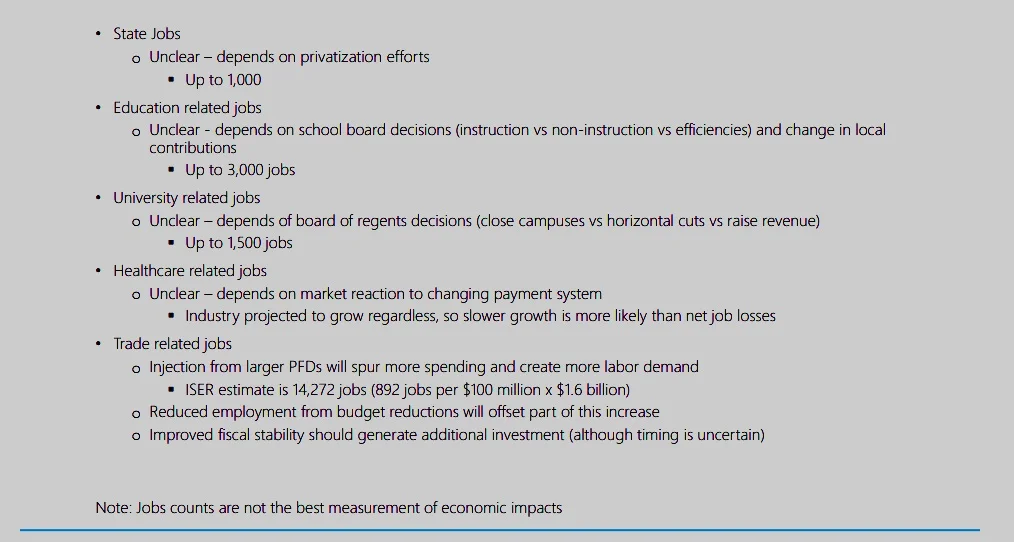Dunleavy administration job loss guess draws on fantasy plan for Alaska
The image below is the Dunleavy administration guess of how many jobs would be lost by eliminating the ferry system, sharply reducing K-12 education and University of Alaska spending, removing $700 million from health care spending in Alaska, confiscating hundreds of millions in taxes from local governments, etc.
As a guess, file this one with all the Nenana Ice Classic tickets predicting breakup on April 31 or Jan. 1.
Even so, when Dunleavy administration chief guesser Ed King presented this list to the Senate Finance Committee, what he said was more optimistic—or delusional—than what he put on his slide, which was delusional enough.
The slide says that up to 5,500 jobs would be lost from state government, K-12 schools and the University of Alaska. But the slide also makes no allowance for jobs that would be lost in health care, despite the $700 million Medicaid reduction that is expected to eliminate thousands of jobs across the state.
And King makes no allowance for the loss of trade sector jobs, merely an assertion that higher Permanent Fund Dividends would “create more labor demand.”
Everything is listed as “unclear,” which is true for all prognostication. But informed guesswork can help clarify the most murky situations.
Let’s look at each guess.
State job losses of up to 1,000. When King spoke about this to legislators he said the number would be “less than 1,000.”
“It could be all the way down to zero theoretically, probably at least 100 though,” he said. “It really just depends on how some of the proposals that are in the budget really play out. Some of those jobs probably turn into private sector jobs, so there’s not an actual net job loss. So 1,000 maximum.”School job losses of up to 3,000. When King spoke about this, he said “it really depends on how the school boards react to the cuts and how the local governments react to the cuts. If they increase taxes in order to protect some of those jobs, obviously those job losses are going to be lower.” He said they might find efficiencies and the school job losses would be “somewhere less than 3,000.”
University job losses of up to 1,500: When King spoke about this, he said it really depends upon how the UA Board of Regents react and whether the university raises tuition, closes campuses or takes other steps. "When I ran the numbers it looked like up to 1,500 jobs might be the maximum, but it’s likely to be something less than that because of how the board will react to that new budget level.”
Health care, zero: King said he included no guess about health care job losses. “I think everybody understands that’s a very complex issue and it warrants very close attention,” he said. Health industry experts worry that the $700 million cut could mean the loss of 7,000 to 9,000 health care jobs in Alaska.
Trade sector, zero: He included no guess about trade sector job losses. “If people that lose their jobs, if their spending really does go to zero, then you would expect to see some reduction in jobs in the trade-related sectors from that activity, but people also are getting more money in their pockets from the PFD, so we would expect that to be expansionary in some form.” The premise is flawed. Spending goes to zero? Suppose the spending drops by 50 percent. That would eliminate some jobs.
“When you net everything out it's something around or something less than 5,000 jobs total. But jobs are really not a good measure of how the economy is functioning anyhow, but just because people are interested in it, I thought I would talk about it a little bit,” King told legislators.
The slide he showed to legislators said the job losses would be up to 5,500, not “less than 5,000” and he did not include any guess about health care job losses, trade sector job losses, or local government job losses. The latter could be substantial based on other parts of the budget. The guesswork is not credible without those elements because zero is not the right number.
The governor’s budget reflects the two-part ideology that temporary budget director Donna Arduin, King’s boss, has promoted in other states: 1. Government bad. 2. Private good.
Investors will gain confidence in Alaska when the budget is stable, King told legislators.
“That reduction in uncertainty will generate some stability which at least in theory will generate some additional investment. I can’t say when. It’s probably not gonna be right away. It’s probably several years in the future. But the theory supports that a stable environment that has low taxes is going to attract more investment and a lot more economic growth,” he said.
Arduin raised that theme the other day, when she talked about people leaving Alaska because of fiscal uncertainty. “The net migration correlates, I’m not saying it’s complete causation, but correlates with unbalanced budgets in the state of Alaska,” she said.
Someone who has been in Alaska since December might say that. A friend said to me later, “When will Donna Arduin be part of the out migration?”
About Alaska, what’s more likely is that this radical budget plan would lead to increased pressure in future years to raise oil taxes, adding instability.
The idea that the Dunleavy Disaster is going to stabilize Alaska’s budget, prevent a population decline and attract a lot more economic growth is ludicrous.

